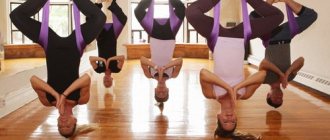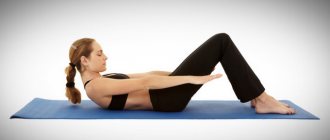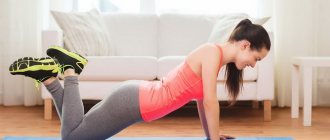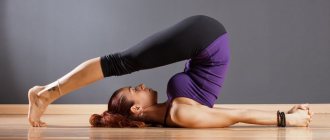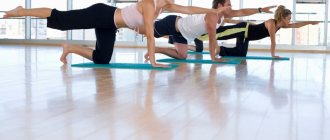What is yoga and where did it come from?
The first mentions of yoga are considered to be the ancient Indian hymns of the Rig Veda of the 11th century. BC e. And the description of the yoga system as an eight-step practice for a person to understand his perfect essence was given to the world by the Indian philosopher Pantajali.
The eight steps of yoga represent eight successive levels, the mastery of which allows the student to achieve liberation from earthly suffering and enter a state of peak energetic capabilities.
- The first two stages of yoga - yama and niyama - constitute the ethical foundations of yoga, the mastery of which lays the spiritual basis for further performance of asana exercises. These include five spiritual principles: not harming living beings, refraining from stealing, lying, sexual lust and possessing unnecessary things.
- At the third stage of yoga - hatha - the practitioner masters asanas that develop the ability to concentrate on body sensations, help remove physical and mental tensions - to activate the movement of energy in the channels. The main goal of practicing the third stage of yoga, the most popular in the West, is not just to train the body, but also to connect with it by directing attention and mastering the skill of controlling one’s somatics.
- At the fourth stage of yoga - pranayama - the student masters the practice of controlling the breath, and through it, the primary energy - prana. Special techniques based on alternating deep and shallow breathing, as well as holding it and directing it throughout the body, allow the practitioner to accumulate vital energy for its subsequent conscious use.
- At the fifth stage of yoga - pratyahara - the adept learns to distract the senses from the objects of the world and maintain a state of consciousness in the “here and now” mode - a way to perceive events without judgment.
- Passing the sixth stage - dharana - gives the useful quality of complete concentration of the mind on the chosen object. It is believed that completely keeping the mind focused on one subject for 12 seconds allows one to move to the seventh level - dhyana, at which one comprehends one's own existence through concentration on the inner world.
- Samadhi is the name of the last, eighth stage of yoga, the practices of which reveal the ability of consciousness to perceive the integrity of oneself and the world, to completely transcend the limits of the limited mind: it is in this state that access to limitless vital energy appears.
Knowledge of the steps of yoga is especially important in light of the mass fascination with its applied side, on the basis of which techniques have been developed for the benefits of losing weight, restoring the spine and other health purposes. The system of yoga practices has a more powerful potential impact: improve not only physical, but also mental health, as well as life in general - thanks to the liberation of consciousness from vanity and anxiety, the ability to listen and hear your body, your spirit, and enter a state of flow with its endless possibilities.
Types of Yoga
The rapidly growing popularity of yoga has opened up a wide variety of directions: from the simplest to advanced practices. The most popular of them:
- Hatha yoga. Research in the USA has proven the benefits of yoga asanas for relieving stress: this is evidenced by the results of women practicing up to two times a week. It is better to start practicing with the classical foundations that were developed by the master Swami Swatmarama: he combined basic hatha asanas with pranayama breathing exercises, meditation, mudras (gestures) and diet.
- Yin yoga. As the name suggests, this is a “feminine”, calm practice designed to relax the body and relieve tension. Asanas are performed in a comfortable position, sitting or lying down at a smooth pace, accompanied by meditative music. Each pose is held for up to 5 minutes, with an important emphasis on breathing.
- Yoga Nidra. Translated as sleep yoga. This direction of yoga is also called “psychic sleep”, or “yogis’ sleep” - a state that is achieved by unidirectional work of the mind through the distraction of the senses in turn from objects of the external world. The practice of Nidra is implemented through entering a borderline state of consciousness and is a powerful method of relaxation, during which the nuclei and centers of the brain are restored, so the benefit lies in its ability to relieve tension and mental blocks, frustration states, release the energy of suppressed desires - gently and without harmful consequences for a person. An hour of such yoga practice replaces four hours of regular sleep and more than one psychotherapy session.
- Bandha yoga. The translation of the name from Sanskrit reflects the nature of the exercises: “tying”, “locking”, that is, pinching, bringing muscle groups to hypertonicity, followed by their relaxation. During this yoga practice, bodily and mental relaxation and a beneficial effect on the hormonal, respiratory, cardiovascular and other systems of the body are achieved.
In addition to classical practices, there are many modern active areas that can be performed in a dynamic mode (for example, Ashtanga Vinyasa - a mixture of yoga with aerobics) or in a strength mode (Power yoga, additionally combined with cardio exercises). There are even yoga practices designed for women who wear heels.
The list of varieties of yogic practices is large, and the choice will depend on the individual characteristics of the person, his state of health, and even age and gender.
How Yoga Really Works: 5 Magic Tools
There is movement in yoga - this is a movement from denser energy to subtler energy. You move from bodily sensation in asanas through pranayama into energy and further, thinner and finer and finer in vibration frequency. The finer the frequency of vibration, the deeper you penetrate. And everything that happens around you also begins to happen at higher vibrations and frequencies. Love, gratitude, joy, delight - these are high-frequency states, and they begin to resonate with you, changing your life and your environment.
Yoga tools help a person return to his original state, when he is perfect and healthy, and discover his inner strength.
There are 8 steps in yoga, which are described by the ancient sage Patanjali. In this article we will not consider them all; we will focus on the practical tools of yoga.
Asanas
Asanas remove blocks in the physical body. For example, the boss yelled at us, we cowered in fear, a spasm occurred in our body, and the resentment was deeply sealed inside. Asanas or body positions allow you to work through these blocks and relax these spasms, releasing old emotions. Energy begins to circulate freely in the body. If we start meditating without working through the body, a powerful flow of energy will act on the body, like a stream of water that was released through clogged pipes - the body may not be able to withstand it, “break.” Therefore, working with the physical body is very important.
Pranayama
Pranayama or breathing techniques build a bridge between the mind and the body. Pranayama has different purposes: some cleanse the body, others allow you to equalize the balance between the left and right hemispheres, the sympathetic and parasympathetic nervous system, others kindle the inner fire, and others calm the mind. In any case, this is one of the most powerful tools of yoga.
Meditation
It is meditation that opens our heart and our consciousness, it leads every person to himself, it opens us to new horizons and our own deep nature. Meditation is a deep and broad concept that we cover in other articles.
Mantras and yantras
Mantras and yantras serve as a reference frequency for tuning our consciousness, for returning to our original frequency; they serve as a kind of tuning fork. Mantras take us beyond the mind into deeper states. Mantras and meditation are subtle mechanisms that influence our destiny, our subconscious, and working with them leads to dramatic changes in life. You can read more about how mantras work here.
Yama and Niyama
Yama and niyama are the “commandments” of yoga, the spiritual principles that underlie it. These are rules: what to do and what not to do - not to be violent, to maintain purity and moderation, to be satisfied with life, etc. To beginning yogis, these rules sometimes seem like theories far from life, but it is the yama and niyama that give a person the greatest strength. When a person’s thoughts, emotions, and actions are aligned according to these principles, even his word begins to have great power. The blessing of such people is more valuable than any gift.
You can read more about yama and niyama here.
Thanks to all these tools, a person practicing yoga returns to his reference frequency, to his center, and begins to make decisions from a different point of view, based on his center. And his life begins to line up differently.
If yoga is such a magical practice, why isn’t everyone around you doing it? Maybe there are some pitfalls?
The benefits of yoga for women
The possibilities of yoga allow a selective approach to physiology: thanks to this, women's practices are a separate area, the benefit of which is to take into account the structural features of the female body and the specifics of the hormonal system.
Improves the functioning of the hormonal system
A woman's hormonal background is regulated by 60 hormones. The work of this system is subtle: even small fluctuations in the ratio of hormones produced by the glands have noticeable changes in the functioning of the entire body. The beneficial effect of yoga practices is the ability to adjust hormonal levels without the use of medications, and this seems fantastic.
Yoga classes have a beneficial effect on the endocrine system at the level of the hypothalamus - pituitary gland - ovaries. When these links are synchronized, the secretions secreted by the glands into the blood and lymph allow the body's biochemical reactions to proceed normally. The imbalance in their work can be immediately determined by changes in the emotional state and behavior of the woman. Thus, the harm of a lack of thyroid hormones is manifested by hysterical reactions.
Information! Masters advise starting yoga practices from adolescence, during the first surges in a girl’s hormonal activity.
An experienced yoga instructor will help you choose a training program based on the individual health and condition of the woman.
The benefits of normalizing the pituitary gland are achieved through the practice of relaxation, which in turn activates blood circulation in the head. To solve this problem, the beneficial properties of inverted asanas, visualization of yoga nidra, meditation and calming breathing of pranayama are good.
To stabilize hormonal levels, asanas are beneficial:
- Bhujangasana (Cobra pose).
- Shirshasana – (headstand).
- Tolasana (Libra pose).
In addition, the following help restore hormonal levels:
- yoga nidra techniques;
- bandhas: Uddiyana (abdominal contractions); Mula Bandha (Root Lock pose performed by squeezing the muscles of the perineum);
- pranayama exercises: Nadi Shodhana (cleansing the channels - breathing alternately through the left and right nostrils; Kapalbhati (“Cleaning the skull” - rapid breathing from the stomach).
Strengthens immunity
The state of immunity is determined by the work of the lymphatic system and spleen, in particular, in the synthesis of immunoglobulins and antibodies. Lymph nodes serve as filters for bacteria that are harmful to the body. And it is the lymphatic system that needs to engage the muscles of the body, in particular through the physical and breathing exercises of yoga. Practicing in yoga poses with the head positioned below the level of the heart will benefit the normalization of the immune system.
A complex of hatha yoga asanas will have a beneficial effect on the immune system:
- Tadasanas (Mountain poses).
- Urdhva Vrikshasana (Inverted Tree Pose - Handstands).
- Uttanasana (Tilting to the feet poses).
- Chaturango Dandasana (Staff poses - variations of the “plank”).
- Adho Mukha Svanasanai (Downward Facing Dog Pose).
Helps fight excess weight
The benefits of yoga, unlike fitness and running, are aimed not so much at combating the consequences of unhealthy habits - burning fat and others, but at eliminating the causes of extra pounds: improper metabolism, hormonal imbalance, and the harm of stress factors. In this regard, the effect of yoga will be long-term.
A set of poses aimed at burning excess fat on the waist, hips, strengthening the muscles of the legs, buttocks and abs, each of which is performed for a minute in three approaches, will be useful for losing weight.
Standing practice:
- Trikonasana (Extended Triangle Pose).
- Virabhadrasana I (Warrior pose).
- Ardha Chandrasana (Crescent Pose).
Practice on the floor:
- Paripurna and Ardha Navasana (half Boat pose).
- Chaturanga Dandasana (Staff Pose).
Of the pranayama exercises, the practice of Kapalbhati (Fire breathing with the belly) will benefit.
Since bad habits take a long time to form, eliminating them by influencing deep processes will also require at least a year of yoga practice. The benefits of accelerating the formation of a slim figure will come from an integrated approach: supplementing yoga practices with diet correction and dynamic physical activity (running, fitness, etc.).
Helps with stress and depression
The best argument for the anti-stress benefits of yoga practice are the results of research: for example, psychiatrists at the University of California found that three times a week for 2 months completely eliminates depressive states.
It will be useful to perform a complex of standing poses:
- Setu Bandhasana (Bridge pose – reminiscent of the “half-bridge” exercise).
- Urdhva Mukha Shavanasana (Upward Facing Dog Pose).
- Yanu Shirshasana (head-to-knee poses).
Practices while lying on the floor:
- Yoga Nidra in Shavasana (Dead Body Pose);
- Ujjayi pranayama (Snake breathing: deep inhalations and exhalations).
Improves sleep
Relaxing yoga poses will also be useful for promoting sleep and regulating breathing. Their benefit lies primarily in the activation of the parasympathetic nervous system.
A practice of six yoga asanas will help you tune in to the wave of sleep:
- Upavistha Konasanas - Staff poses.
- Salabhasanas (Locust poses).
- Viparita Karani (Bent Candle Pose).
- Supta Baddha Konasana (lying butterfly pose).
- Yathara Parivartanasana (Side Twisting Pose).
- Savasanas (dead body poses).
Rejuvenates
The best motivation to use the rejuvenating effects of classes is the beautiful shape of such unfading yoga fans as, for example, Madonna and Julia Roberts.
Indeed, the omnipotence of yoga also lies in its regenerating effect, which, of course, is associated with a complex effect on the immune system and hormonal system, on improving blood supply to organs and tissues. Yoga practices will immediately affect the skin and general tone of the body, and will also benefit women over 40 for the smoothest possible passage of menopause, and for maintaining excellent condition in old age.
We recommend reading: The best vitamins for women over 40: reviews, names, which ones to choose
First of all, inverted poses are known to have beneficial anti-aging effects:
- Sarvangasana (“birch tree”);
- Viparita-Karani Mudra (Bent Candle pose - like an incomplete version of the “birch tree”, when the hips rest on the hands behind the back).
Further benefits will come from practicing a group of restorative asanas:
- Supta Baddha Konasana (lying butterfly pose).
- Setu Bandhasana (Bridge or Half-Bridge poses).
- Balasanas (Child's poses).
The poses are performed gently and leisurely to prevent harm to muscles, joints, and bones.
Develops flexibility
A virtually limitless arsenal of yoga asanas can be used to develop flexibility. The benefits of the practice lie in its useful focus on the absence of tension, which, with proper preparation, does not cause harm to injury to body tissues.
Therefore, it is first recommended to warm up with the help of dynamic joint yoga gymnastics - sukcham kriya. Next, it will be useful to perform simple breathing techniques of pranayama with a gradual “stretching” of inhalation and exhalation. The resulting feeling of relaxation will create the necessary “fluid” state, which will allow you to join in the performance of the asana. Yoga classes are completed by relaxing in Sivasana (dead man's pose) to neutralize any possible pressure and tension.
Relieves headaches
To relieve headaches, you should start by eliminating general tension. This is where the use of Nadi’s technique comes in handy - for cleansing the channels. Thus, the practice of simple Nadi Shodhana consists of alternately inhaling through one nostril and exhaling more slowly (twice as long) through the other (the non-working nostril is pinched with your hand). Methodically performing the exercise will help the pain subside.
Video lesson on the practice of entry-level yoga asanas to eliminate headaches:
Reduces blood sugar and cholesterol levels
For diabetes mellitus, a complex of twisting, bending and inverted poses works. The results of a group of subjects who, after a three-month course of yoga classes, brought their blood count to normal were recorded. In addition, for diabetes and excess cholesterol in the blood, experts recommend practicing “hot yoga” (Bikram yoga). You can normalize your blood composition with a complex of asanas:
- Ardha Matsyendrasa (Back Twisting poses).
- Ardha Gomukhasana (Cow Head Pose).
- Vajrasana (Diamond poses).
- Paschimottanasana (butt stretching poses).
- Virabhadrasana (Warrior poses).
- Malasana (Garland poses).
Relieves pain during menstruation
Premenstrual syndrome is often the body's reaction to stress factors. When dealing with this problem, poses are chosen from yoga practice that increase the production of antidepressant hormones.
Regular practice of the already familiar Sarvangasana (“Birch Tree”) and Viparita Karani (Bent Candle) poses, as well as Halasana (Plow Pose), which reduce estrogen secretion, will bring a beneficial effect in debugging the menstrual cycle.
During critical days, on the contrary, inverted asanas are replaced by those that reduce estrogen production.
If there is heavy discharge, the following will be beneficial:
- Chandrasana (Crescent poses).
- Utthita Hasta Padangusthasana (Stretched Arm Pose).
For menstrual pain, the above-mentioned Supta Baddha Konasana (lying Butterfly pose) will be useful.
Helps get pregnant
The practice of yoga should begin even before conception in order to comprehensively prepare the body for pregnancy and childbirth. First of all, perform familiar asanas that help normalize blood circulation in the pelvic area.
- Viparita Karani (Bent Candle pose) - it is better to perform it with your feet against the wall;
- Setu Bandha Sarvangasana (Bridge pose, or “half bridge”).
The second group of yoga poses mentioned above helps expand the space in the pelvic area and relieve tension:
- Salamba Baddha Konasana (lying Butterfly pose);
- Shavasanas (Dead body poses).
The practice of the third group of yoga asanas will be beneficial in generally stimulating blood circulation in the reproductive system:
- Paschimottanasana (Forward Bend to the Knee poses).
- Hastapadasana (Stork pose, or Bend to the feet).
- Janu Shirshasana (Head on Knee Pose).
- Urdhva Dhanurasana (Bow or “bridge” poses).
Power yoga for advanced
If a person has been practicing yoga for a long time, then the set of exercises should be very diverse. Exercises that are available to experienced athletes:
- Bhujangasana. The pose is aimed at strengthening the gluteal muscle. It is useful to perform it for people who overstrain the spinal column during the day. This asana is also called cobra pose. It involves a significant arch in the back. Beginners can adapt it to their capabilities.
- Ardha Matsyendrasana, known as the King of the Pisces Pose. It is performed in a sitting position. One leg will need to be placed behind the other thigh. The asana requires a person to have good joint flexibility and high-quality stretching. In the process of performing it, the abdominal muscles, neck and shoulder joints are involved.
- Chaturanga Dandasana or Staff Pose. It resembles a plank, but the emphasis is on the toes and palms, rather than on the elbows. The body should be straight, like an arrow. During this exercise, all muscles work.
- Grasshopper pose. The person lies on his stomach, stretches his arms along the body. At the same time, the head and legs are torn off the floor (the height should be about 10 cm). Raise your hands and stretch them towards your heels. You need to bend in the lumbar region. Stay in this position for 30 seconds.
Experienced people who practice yoga can structure the workout at their own discretion. It all depends on the goal that a person pursues. It can work specific muscle groups or improve the tone of the body as a whole.
When performing strength exercises, you need to monitor your breathing. It should not be confusing or uneven. If it cannot be restored, it means that the exercises are being performed incorrectly.
Is yoga good for children?
The child’s body, like the psyche, is more flexible and pliable to yoga, since it has practically no blocks. For children, the benefit of practicing yoga is to teach them a love for exercise and the ability to listen to their body: to do this, they need to be helped to pay attention to the area that tenses in the asana.
By the age of 10–15 years, as the reproductive system develops, the body is subject to hormonal fluctuations. An arsenal of yoga tools can also relieve the instability of the psycho-emotional sphere associated with these processes, to which adolescents are so susceptible.
The practice of inverted asanas and bending back and forth will be useful for stimulating the pituitary gland and ensuring blood flow to the abdominal organs. In addition, yoga classes will help in shaping the correct development of the musculoskeletal system and prevent the harmful effects of scoliosis and other spinal problems.
How is yoga beneficial for women's health?
Women's yoga brings harmony to health and allows you to get rid of difficulties of various kinds.
This happens by performing practical exercises that act on all three levels of the endocrine system - the hypothalamus, pituitary gland and ovaries. With the coordinated interaction of these levels, hormonal and biochemical processes proceed correctly. What does women's practice provide and why is it needed:
- formation of correct posture, normalization of metabolism, getting rid of extra pounds;
- increasing muscle elasticity and flexibility if you do asanas such as Parshvottanasana, Adho Mukha Svanasana, Virasana, Virabhadrasana 1 and others on a regular basis;
- strengthening the immune system , increasing the protective barrier of the female body to common diseases;
- the skin is cleansed, becomes elastic, toned, tightened, the appearance of swelling and wrinkles is prevented;
- strengthening blood vessels , normalizing blood pressure, reducing blood viscosity, which reduces the risk of stroke;
- normalization of the hormonal system (including increased appetite goes away);
- improvement of blood circulation , blood supply with oxygen; cleansing cells of toxins, improving brain activity (an exercise with your head upside down, for example, Shashankasana, is suitable for this);
- the processes of rejuvenation of the body are launched;
- weakening of pain syndromes during menstruation and the premenstrual period;
- improved sleep , easy adaptation to stressful situations, relief from depression and anxiety.
Yoga has a powerful effect on the body, which becomes noticeable after just a month of regular practice.
Rules for practicing yoga for beginners
The rules regarding classes are indicative in nature, since the practice of yoga is very dependent on the individual characteristics of the body. General recommendations may concern:
- Eating before and after yoga classes. Yoga practice should be performed on a light stomach: food should be eaten no later than two hours before class. After classes, it’s enough to wait half an hour: the body needs a smooth transition to a new type of energy that food provides.
- Drinking. Drinking water is encouraged, but not during asanas. However, pranayama requires limiting the consumption of water before class. The exception may be a small amount of hot or warm liquid.
- Water procedures. Before practicing yoga, it will be useful to take a warm or cool shower. After classes, a shower is not necessary, unless dynamic practices were performed, after which sweating is possible. Taking a hot bath or sauna (both before and after a session) can negate all the benefits of yoga practice.
- Newbie mistakes.
You should not strive to perform asanas “perfectly” or perform complex twists at once: it is more important to learn to find “contact” with the sensations of the body. It is better to start any yoga pose with a lighter version, gradually increasing the depth of the asana as the strength relaxes. Important! You can get harmed by injury to muscles and ligaments in the practice of asanas only if you ignore the sensations and prompts of your body. - Food quality. As you practice yoga, the body itself will require changes in the menu, especially if the diet contains heavy foods. It is better to focus on fresh organic food, with a reasonable addition of spices as natural food additives.
Benefit
The main goal of power yoga is to strengthen the muscular frame and musculoskeletal system. Dynamic exercises prevent joints from becoming stiff and allow the spine to be flexible and maintain a healthy, beautiful posture. Balance exercises improve coordination. In general, the practice has a positive effect on the cardiovascular and nervous systems. It can be performed every day; it does not cause emotional fatigue; on the contrary, it improves overall tone and mood.
Don’t forget about the external effect that power yoga produces. Regular exercises with a gradual increase in the number of approaches and degree of load form an athletic figure. In this case, no additional projectiles are needed, with the exception of your own body weight.
When and where is the best time to do yoga?
To start practicing yoga, it is better to enroll in a group for beginners. To then decide which direction is suitable, a trial visit to yoga groups of various directions will be beneficial.
The benefits of yoga are not limited: if you wish, you can practice even every day. A frequency of 2-3 sessions per week will be useful, with an average duration of 1 hour, and practices with a frequency of 3-4 times will be optimal in terms of productivity.
It will be possible to switch to independent yoga classes after mastering basic techniques from an experienced master and building an approximate individual program.
Active physical exercises of hathi yoga are best performed in the first half of the day, while breathing practices of pranayama and meditation sessions will be beneficial at any time of the day.
Exercises for beginners at home
Beginners are recommended simple yoga exercise techniques, which, despite their simplicity, can have a powerful effect on the body. The benefits of the gentle impact of the practice on the joints are especially important at the very beginning - to prevent the harm of their injury and to gradually prepare the muscles and ligaments for subsequent levels of yoga, with twisting, bending, and stretching poses. For example, it is better to replace the practice of the Lotus pose with a simpler one - with crossed legs, and developing the mobility of the hip joints will allow you to naturally move into the full position.
A necessary and mandatory element of any system is pranayama breathing exercises. You should start with simple breathing techniques while sitting with your back straight. Watching the flow of your breath, observe how the inhalation is directed from the stomach and reaches the collarbones, and then, following the exhalation, lower your attention from the collarbones back to the stomach. A simple yoga exercise on concentrating inhalation and exhalation can be complicated by holding your breath comfortably as you exhale.
From the video you can familiarize yourself with a set of asanas that will benefit beginners in practicing yoga:
Power yoga asanas for beginners
People who have just started practicing power yoga should stick to basic asanas. In practice, there are more than 300 of them, but there are 7 main poses that you need to pay special attention to:
- Kumbhakasana (plank). The exercise is performed lying down, with emphasis on the elbows and toes. The muscles of the buttocks, back and abs should be tense all the time.
- Trikonasana (triangle). Your feet should be shoulder-width apart, with your left foot turned to the left. The right arm is raised up and tilted to the left until the straight left arm rests on the floor. Stay in this position for a few seconds (for beginners, 2-3 inhalations and exhalations are enough). Then the exercise is repeated for the right leg.
- Vrikshasana (Tree Pose). You need to stand up straight, while inhaling, raise your right leg, bending it at the knee, and press your foot to the inner thigh of your left leg. The palms are connected to each other at chest level, the shoulders are straightened. You need to stay in this position as long as possible. Then the legs are changed.
- Virabhadrasana. Standing straight, you need to lunge with your left leg, bending it at the knee joint. The right foot should remain firmly pressed to the floor. Hands are raised up. Stay in this position for a minute, return to the starting position and repeat the exercise for the right leg.
- Paschimottanasana (baby pose). While on all fours, you need to press your buttocks to your heels and extend your arms forward. Their foreheads touch the floor. Remain in this position for 2-3 minutes.
- Navasana (boat pose). You need to lie on your back, while inhaling, lift your neck, shoulders, upper and lower limbs off the floor. Palms and feet stretch upward.
- Rudrasana. The legs are spread wide, the feet are turned in different directions. The palms are connected to each other, placing them at chest level. The knees begin to bend until the thighs are at right angles to the shins. Beginners should remain in this position for 60 seconds.
During training, you need to work out all parts of the body. You can’t work only on problem areas. The entire body must be subject to stress. The process involves arms, legs, back, abs, and hips.
Contraindications to yoga
The benefits and harms of yoga depend on chronic diseases and the proper selection of techniques. Sitting in a relaxed Lotus position with crossed legs, as well as practicing meditation or the simplest pranayama exercises, are unlikely to cause harm to health. But a well-designed complex must necessarily take into account contraindications.
Basic diseases that impose strict restrictions on yoga practices include:
- fever, high temperature;
- acute infectious diseases, suppuration;
- diseases of the circulatory system: myocardial infarction, hypertension;
- acute and subacute period of chronic diseases;
- musculoskeletal system injuries - up to 6 months of rehabilitation;
- some neurological and mental diseases;
- serous or purulent otitis media;
- retinal detachment.
Caution should also be exercised in case of osteochondrosis - due to the possible harm caused by pinching the spinal cord roots.
Consultation with a medical specialist is necessary in case of reduced blood clotting: performing inverted asanas can cause harm due to possible bleeding.
Restrictions on yoga also apply to the postpartum period - up to three months.
Basic complex for beginners
Basic asanas, like no other, are suitable for beginners to practice power yoga. They will help you master the correct breathing and relaxation techniques and serve as the foundation for increasing muscle strength.
Legendary meditation course without payment We recommend! The most popular meditation course for beginners in Russian. More than 100 thousand people have already learned to meditate. Try it yourself. Read more.
Power yoga includes approximately 300 basic poses. Experienced trainers recommend that beginners use only a few asanas for each workout. This will allow you to create a rich and effective training program.
Achieving success in yoga is impossible without taking into account the capabilities of your body. For this reason, if you feel unwell or dizzy, stop exercising and modify the exercise.
A complex of several asanas (suitable for men and women):
- Rudrasana (sumo pose) . Among power asanas, one of the most powerful. Exercise develops strength and endurance. It is suitable for training the lower back and back, hips, knees and ankles, and abs.
- “Six points” or plank (Kumbhakasana). The asana strengthens the muscles of the body and develops the ability to maintain balance.
- "Tree" (Vrikshasana). An effective exercise for developing flexibility. A novice yogi, having learned to perform the asana, can balance on one leg and control his own breathing.
- Warrior asana (Virabhadrasana). Increases certain qualities of strength and endurance required for yoga practice. The effect is achieved by stretching and strengthening the gluteal and thigh muscles.
- "Boat" (Navasana). Strengthens the abdominal and back muscles, as well as the arms and shoulder girdle.
- Shalabhasana (locust or grasshopper pose). It is used to tone the lower body and increase physical endurance.
